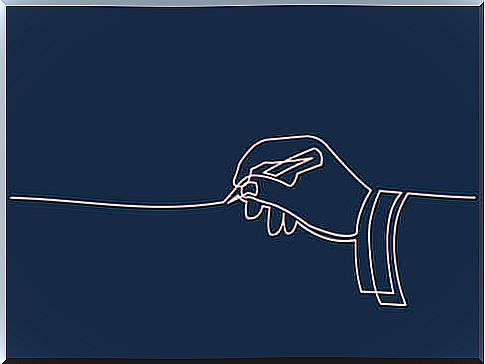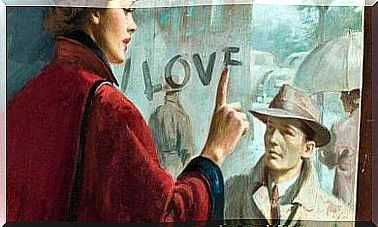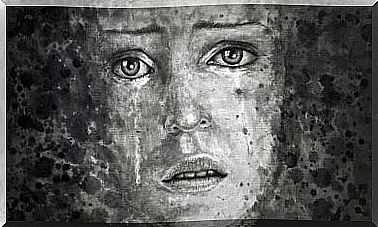The Line Of Life, A Technique To Get To Know Yourself Better

In psychology a great diversity of techniques and tools are used during the therapeutic process, one of the techniques used to gain self-knowledge and understanding of oneself is the life line technique. Although it is a technique with a humanistic and systemic perspective, psychologists of different currents also use it because it gives us a lot of information about the patient / client.
People are a history, a present and a future, and everything comes together in our individuality. We are also a story, of everything that has happened to us in our life history, and knowing how to order it and give meaning to our history is essential to grow as people, have confidence in ourselves and accept ourselves without complexes. Therefore, the objective of this post is that you understand how the life line technique works and when it is good to use it.
How does the life line technique work?
The basic operation of this technique is analysis and reflection, that is to say, it is not a technique that simply by “doing” it produces a result but, for it to take effect, an analytical and reflective effort is necessary. Thus, in the first place, the fact of analyzing all or part of our life history (life line) allows us to channel and manage the different associated emotions : the same with which we often live, but also those that we have not. consciously managed.
Once the line is drawn, we must delve into the meaning of each element that we have drawn on it. The life line technique requires a reflective analysis that is usually guided by questions such as: what has changed in me as a result of this experience? What did I lose and what did I gain at that time? Is this experience over? Among others. With all this, we manage to elaborate the experiences in a healthy and adaptive way, and in this way to know and understand ourselves better, because we are able to unite our past with our present in a constructive way.

The best times to use this technique
The life line can be used at (almost) any time; However, it is better to use it: at the beginning of a therapeutic process or to close a stage of confusion. Also, the life line is a very useful technique whenever you want to know yourself better, because by understanding everything you have experienced, you understand why you act as you act and feel how you feel.
On the other hand, it would not be indicated to perform the life line technique as soon as painful and traumatic experiences have been lived. This is because, according to a study carried out by the University of Arizona, within a period of grief (or reaction to loss) we can observe phases of depression. In other words, while experiencing a phase of loss or trauma, this technique is not indicated because it is likely that the state of mind introduces a negative bias in the analysis.
How this technique is carried out: steps to carry it out
To carry out this technique, as we have commented, you have to consider two phases of work: the elaboration of the life line and the phase of critical-reflective analysis. Thus, in the first place you basically only need paper and pencil, draw a straight line and begin to indicate the following points in it in chronological order:
1. Define and indicate your life events such as: your birth, the birth of siblings, cousins or children, the death of loved ones, the beginning of life as a couple or marriage, etc. For this part you can use the color blue.
2. Also indicate significant events or very important moments in your life, which represent a change. For example: a change of residence, the beginning or end of studies, a highly desired or significant trip, among others. You will be the person who identifies what is important. For these events on the line you can use the color green.

3. At this point you need to mark your inflection moments on the line. We understand that these function as keys to open phases or crisis situations that are assumed and prepared appropriately. Thus, you can use the color red for these moments of inflection, and you have to especially mark those in which you feel that they have made you stronger.
4. Finally, you have to point out situations or moments of “cut”. We refer to situations that marked a before and after in your life, you perceive them as moments of rupture of what was your life and your routine and they are also difficult to elaborate or they are traumatic. For these events you can use black or a dark color that contrasts with the rest of the brands.
Once you have drawn up the life line, you will have to spend some time analyzing the impact that each and every one of the events you have marked has on your life. It is important that you go beyond what you see drawn on the line and that you delve into its consequences. Remember: knowing yourself is the necessary step for development and overcoming personal limits.
Objectives of the lifeline
Among the goals of the lifeline are the ordering of events in our history to preserve them alive, as well as obtaining a resource to find them easily if we need them.
For its part, carrying out this technique can help us understand :
- What vision we have of life.
- What are our priorities.
- What memories we keep from childhood and how they have influenced the present.
- How many changes have we made over time and what have their characteristics been?
- How we live today and how we think about the future.
That said, it is pertinent to note that this is not an easy task. For this, that requires a lot of reflection, concentration and the ability to synthesize.
In this case, the memory of events is necessary to learn from history and understand what happened at a given moment. It is also important to understand what happened in order to build a future.
The life line will make it easier for us to know how we have reached the present point, and it will show what were the decisions that were made at each moment and how they evolved creating new situations and experiences.
It should be noted that the life line does not work to judge or regret our decisions. Instead, it serves to understand why we are taking a particular path at any given time and what direction we want to follow from now on.









